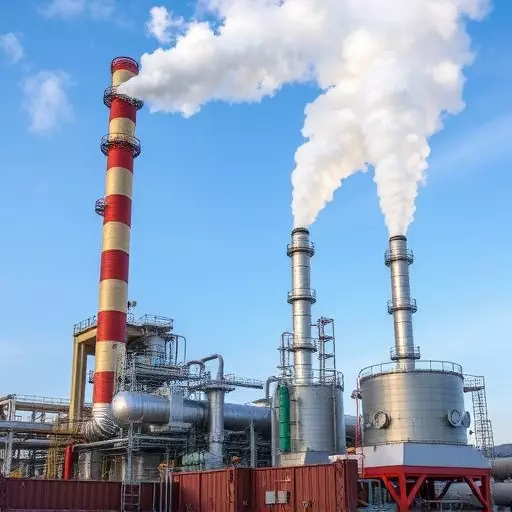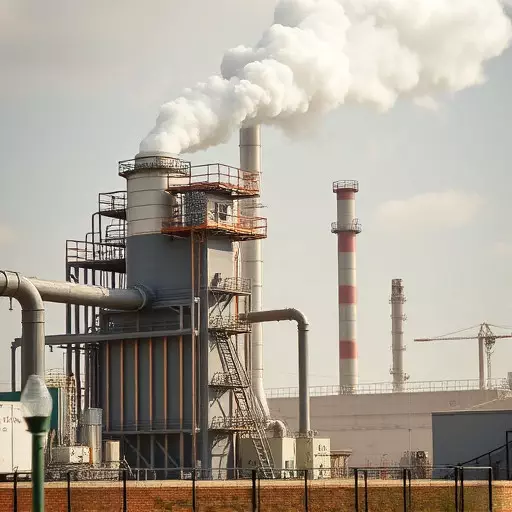Industrial activities release harmful pollutants like PM2.5, PM10, NOx, SO2, VOCs, and toxic metals, contributing to air pollution and health risks. To mitigate these issues, implementing advanced air quality solutions for industrial sites is crucial. These include efficient dust collection solutions for crushing, grinding, and material handling, as well as emission control technologies like scrubbers, filters, and electrostatic precipitators. Regular monitoring and maintenance ensure compliance with standards, resulting in cleaner air and healthier communities. Key strategies focus on reducing particulate matter, nitrogen oxides, sulfur dioxide, and volatile organic compounds through tailored emission control systems.
Air pollution from industrial activities poses significant risks to human health and the environment. In this article, we explore comprehensive strategies to combat this challenge. We delve into identifying sources of industrial air pollution, highlighting common contributors and their impacts. Effective dust collection solutions are crucial, detailing best practices for implementing various systems.
Moreover, we examine advanced emission control technologies like scrubbers and filters, supported by real-world case studies. Regulatory standards play a vital role in driving emission reductions.
Finally, we discuss fostering sustainable industrial growth through integrated air quality solutions, community collaboration, and future innovations.
- Identifying Sources of Industrial Air Pollution
- – Common industrial activities contributing to air pollution
- – Different types of emissions and their impact on air quality
- Implementing Effective Dust Collection Solutions
Identifying Sources of Industrial Air Pollution

Industrial activities are a significant contributor to air pollution, releasing various harmful pollutants into the atmosphere. Identifying and understanding the sources of industrial air pollution is the first step towards finding effective solutions. Many industrial sites emit pollutants such as particulate matter (PM2.5 and PM10), nitrogen oxides (NOx), sulfur dioxide (SO2), volatile organic compounds (VOCs), and toxic metals, affecting local air quality and public health.
Air quality solutions for industrial sites include implementing robust dust collection systems to capture and control emissions from processes like crushing, grinding, and material handling. Additionally, emission control technologies such as scrubbers, filters, and electrostatic precipitators can be employed to reduce the release of pollutants into the air. These measures, coupled with regular monitoring and maintenance, help industries minimize their environmental impact while ensuring compliance with regulatory standards, contributing to cleaner air and healthier communities.
– Common industrial activities contributing to air pollution

Industrial activities play a significant role in contributing to air pollution, particularly in urban areas and heavily industrialized regions. Common practices such as manufacturing processes, construction sites, and mining operations emit various pollutants into the atmosphere. One of the primary culprits is the release of particulate matter, including dust and soot, which can be detrimental to human health and the environment. These particles often result from activities like crushing and grinding materials, demolition, and the handling of dusty substances without proper containment measures.
Implementing air quality solutions for industrial sites is essential in mitigating these issues. Effective dust collection solutions, such as advanced filtration systems and local exhaust ventilation, can significantly reduce the emission of particulate matter. Additionally, integrating emission control technologies like scrubbers, filters, and scrubber-absorbent systems can capture and minimize pollutants before they are released into the air. These measures not only improve local air quality but also contribute to global efforts in combating climate change by reducing industrial carbon footprints.
– Different types of emissions and their impact on air quality

Air pollution is a complex issue, stemming from various sources and types of emissions that collectively impact air quality. Industrial sites play a significant role in this puzzle, as they emit a range of pollutants into the atmosphere. These include particulate matter, such as dust and soot, which can penetrate deep into the lungs and cause respiratory issues. Gases like nitrogen oxides (NOx) and sulfur dioxide (SO2) contribute to smog formation and acid rain, posing risks to both human health and ecosystems. Additionally, volatile organic compounds (VOCs) from industrial processes can react with other pollutants to form ground-level ozone, a harmful gas that irritates the respiratory tract.
Implementing air quality solutions for industrial sites is paramount in combating these issues. Effective dust collection solutions are crucial to mitigate particulate matter emissions, ensuring that industries capture and control dust at its source. Emission control technologies, such as scrubbers and filters, can significantly reduce NOx, SO2, and VOCs. Advanced methods like electrostatic precipitators and baghouses further enhance air quality by trapping fine particles. These strategies not only improve local air quality but also contribute to global efforts in tackling climate change and fostering a healthier environment.
Implementing Effective Dust Collection Solutions

Implementing effective dust collection solutions is a critical step in enhancing air quality solutions for industrial sites. These systems are designed to capture and contain airborne particles, preventing them from escaping into the atmosphere. By employing advanced emission control technologies, industries can significantly reduce their environmental impact and contribute to healthier working conditions. Modern dust collection systems use a variety of methods, such as cyclonic separation, filter bags, and electrostatic precipitation, to ensure efficient removal of dust and debris.
For industrial sites, selecting the right dust collection solution involves understanding the specific processes generating dust, the size and type of particles involved, and the overall facility layout. Customized systems that account for these factors can offer tailored air quality solutions, minimizing operational disruptions while maximizing pollution control efficiency. Regular maintenance and filtering changes are also vital to keep these systems functioning optimally, ensuring continued protection of both the environment and workers’ health.


